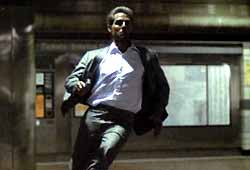|
||||||||||||||||||
| USA, 2004 directed by Michael Mann, starring Tom Cruise, Jamie Foxx, Mark Ruffalo, Javier Bardem, Jada Pinkett-Smith, Bruce McGill Among those who loaded the movie-related imaging with deep meanings, Michael Mann’s work has been the most rigorous and coherent in the last twenty years of American Cinema. Even after the split-up with his trusted director of photography Dante Spinotti - with whom he’s been working since Insider, probably the highest point in the careers of both of them - the filmmaker has carried on an absolutely precise and recognizable view of Cinema, whose main feature is image composition. A single frame from Manhunter, Heat or Ali contains in itself a work of experimentation and a strong signification, which is very hard to find, at the same coherence and consciousness level, in other directors' work. The image framing and angling, the use of focus or wide lenses, or more simply the use of light: all this, combined together and in accordance with the same aesthetic philosophy, lead to the composition of a beautiful mosaic made of different movies linked together, whose fil rouge is the powerfully meaningful work on the image. Now, what is fascinating in Mann’s work is that he actually boosts his cinematic vision by taking something away from the other features of a movie. Mann's close-ups of Al Pacino, Robert De Niro, Russell Crowe, William Petersen or Will Smith, alone contain a great amount of psychological information: such a primal intensity allows the director to downsize words and dialogue lines, reaching a sublimation that lightens up and slims all of his movies. In Mann’s best works, visual stylization manages to exclude words; images get more rarefied and precious, becoming the first and only vehicle of storytelling, always heading towards an extraordinary process of synthesis. According to this stylistic choice, Mann's try in digital filmmaking sounds totally consistent. Digital cinema - coherently spent and not considered as film's grim twin - completely strips down the image and, at the same time, definitively states its importance. From this point of view, Collateral represents, aside from the brilliant aesthetic result, the most risky and experimental of Mann’s works. Here, digital imaging achieves something Mann was always looking for: locations and characters merge into a single blur made of colors and darkness. Through the flatness and the lack of depth of digital images, the director rendered his sad and shining Los Angeles through a series of pictures that we could hazardously define as surreal. The edgy story of a taxi driver (Jamie Foxx) and his disquieting passenger (Tom Cruise) takes place in empty streets full of dense and saturated colors, like the Club, and mainly the taxi, where the two antagonists meet and face. All locations are at the same time abstract and real, simply recognizable but impossible to identify, and they too play a pivotal role in the movie's greatly successful stylization attempt. Moreover, Collateral is a tight and involving thriller, full of great speed-ups and unique action sequences. It's surprising how perfectly such a stark and peculiar filmmaking project merges with a very specific attention to genre's rules, rules fully followed also by Stuart Beattie’s excellent screenplay. Rigorous and experimental, dirty and sublime, Collateral takes us for two hours into the most incredible one-night-ride of all: Jamie Foxx and Tom Cruise expose their talents filling up two characters full of peculiarities, two characters that express their inner life in an instinctual, almost feral way, reacting to the laws of the urban jungle. Michael Mann, in some way, has truly realized his masterpiece, reaching the highest point in every single element of moviemaking. His best skill - building up stories in order to bring tension up to the climax with the most intense cinematic results - is expressed here in a stunning way: Collateral’s last twenty minutes are a visual, chromatic, musical and - above all - emotional symphony that won’t be forgotten. |
||||||||||||||||||

